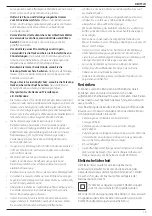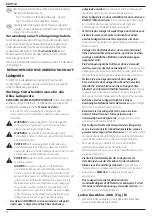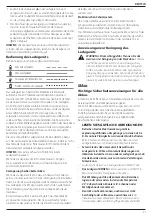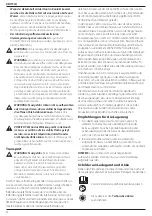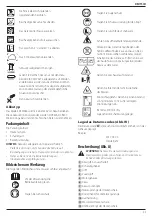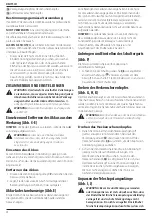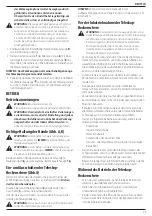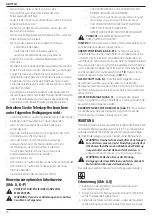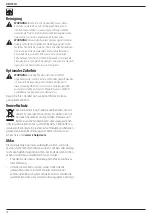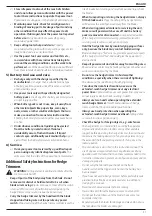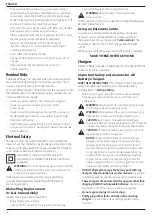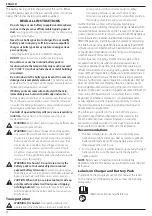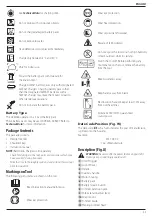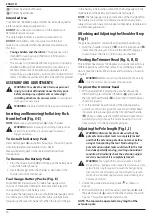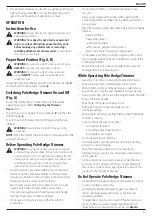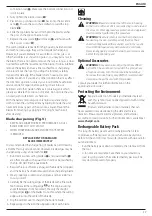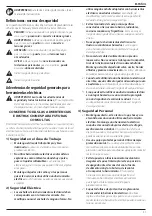
33
EnGLIsH
•
Make sure that cord is located so that it will not be
stepped on, tripped over, or otherwise subjected to
damage or stress.
•
Do not use an extension cord unless it is absolutely
necessary.
Use of improper extension cord could result in risk
of fire,electric shock, or electrocution.
•
Do not place any object on top of charger or place
the charger on a soft surface that might block the
ventilation slots and result in excessive internal heat.
Place the charger in a position away from any heat source. The
charger is ventilated through slots in the top and the bottom
of the housing.
•
Do not operate charger with damaged cord or plug—
have them replaced immediately.
•
Do not operate charger if it has received a sharp blow,
been dropped, or otherwise damaged in any way.
Take it
to an authorised service centre.
•
Do not disassemble charger; take it to an authorised
service centre when service or repair is required.
Incorrect
reassembly may result in a risk of electric shock, electrocution
or fire.
• In case of damaged power supply cord the supply cord must
be replaced immediately by the manufacturer, its service agent
or similar qualified person to prevent any hazard.
•
Disconnect the charger from the outlet before
attempting any cleaning. This will reduce the risk of
electric shock.
Removing the battery pack will not reduce
this risk.
•
NEVER
attempt to connect two chargers together.
•
The charger is designed to operate on standard
230V household electrical power. Do not attempt to
use it on any other voltage.
This does not apply to the
vehicular charger.
Charging a Battery (Fig. B)
1. Plug the charger into an appropriate outlet before inserting
battery pack.
2. Insert the battery pack
6
into the charger, making sure the
battery pack is fully seated in the charger. The red (charging)
light will blink repeatedly indicating that the charging
process has started.
3. The completion of charge will be indicated by the red
light remaining ON continuously. The battery pack is fully
charged and may be used at this time or left in the charger.
To remove the battery pack from the charger, push the
battery release button
7
on the battery pack.
nOTE:
To ensure maximum performance and life of lithium-ion
battery packs, charge the battery pack fully before first use.
Charger Operation
Refer to the indicators below for the charge status of the
battery pack.
Pack Charging
Pack Charged
Hot/Cold Pack Delay
Problem Pack or Charger
This charger is designed to detect certain problems that can
arise. Problems are indicated by the red light flashing at a fast
rate. If this occurs, remove and then reinsert the battery pack
into the charger. If the problem persists, try a different battery
pack to determine if the charger is working properly. If the new
pack charges correctly, then the original pack is defective and
should be returned to a service center or other collection site
for recycling. If the new battery pack elicits the same trouble
indication as the original, have the charger and the battery pack
tested at an authorized service center.
The compatible charger(s) will not charge a faulty battery pack.
The charger will indicate faulty battery by refusing to light or by
displaying problem pack or charger blink pattern.
nOTE:
This could also mean a problem with a charger.
If the charger indicates a problem, take the charger and battery
pack to be tested at an authorised service centre.
Hot/cold Pack Delay
When the charger detects a battery pack that is too hot or too
cold, it automatically starts a Hot/Cold Pack Delay, suspending
charging until the battery pack has reached an appropriate
temperature. The charger then automatically switches to the
pack charging mode. This feature ensures maximum battery
pack life.
A cold battery pack will charge at a slower rate than a warm
battery pack. The battery pack will charge at that slower rate
throughout the entire charging cycle and will not return to
maximum charge rate even if the battery pack warms.
Electronic Protection system
XR Li-Ion tools are designed with an Electronic Protection
System that will protect the battery pack against overloading,
overheating or deep discharge.
The tool will automatically turn off if the Electronic Protection
System engages. If this occurs, place the lithium-ion battery
pack on the charger until it is fully charged.
Charger Cleaning Instructions
WARNING: Shock hazard. Disconnect the charger
from the AC outlet before cleaning
. Dirt and grease
may be removed from the exterior of the charger using a
cloth or soft non-metallic brush. Do not use water or any
cleaning solutions. Never let any liquid get inside the tool;
never immerse any part of the tool into a liquid.
Battery Packs
Important Safety Instructions for All
Battery Packs
When ordering replacement battery packs, be sure to include
catalog number and voltage.
Summary of Contents for Pro Landscaping DCM586
Page 1: ...DCM586 ...
Page 3: ...1 Fig A Fig B Fig C Fig D 6 6 7 11 9 8 7 5 6 4 2 1 3 10 12 13 14 7 ...
Page 4: ...2 13 14 Fig F Fig H Fig E Fig G Fig I Fig J Fig L Fig K 10 15 9 8 4 ...
Page 5: ...3 Fig N Fig O Fig P Fig Q Fig R 16 Fig S Fig T 17 18 19 21 20 22 11 25 24 23 26 Fig M ...
Page 6: ...4 Fig V Fig U Fig W 27 29 30 28 31 ...
Page 161: ...159 ...
Page 162: ...160 ...
Page 163: ...161 ...

